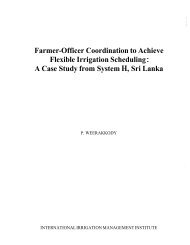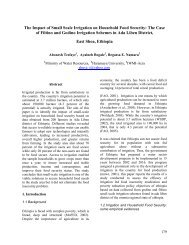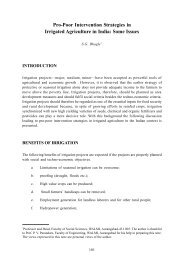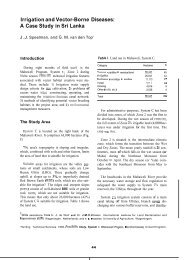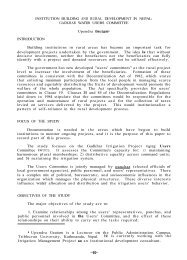WATER POVERTY IN THE NORTHEASTERN HILL REGION (INDIA)
WATER POVERTY IN THE NORTHEASTERN HILL REGION (INDIA)
WATER POVERTY IN THE NORTHEASTERN HILL REGION (INDIA)
You also want an ePaper? Increase the reach of your titles
YUMPU automatically turns print PDFs into web optimized ePapers that Google loves.
<strong>WATER</strong> <strong>POVERTY</strong> <strong>IN</strong> <strong>THE</strong> NOR<strong>THE</strong>ASTERN <strong>HILL</strong> <strong>REGION</strong> (<strong>IN</strong>DIA): POTENTIAL ALLEVIATION THROUGH MULTIPLE-USE <strong>WATER</strong> SYSTEMSlevel to put their ideas and problems to others. Also, it was reported that there has been increasedconsultation between men and women in carrying out farm activities in the recent years as comparedto past traditions.iii.Increase in household incomeMUS technology encouraged the farmers for productive activities enabling them to earn cash incomewhich was an added incentive to the household (especially women). Households who had used MUS formore than one year have reported income from vegetables, which were important for food sufficiencyand security, increased nutrient intake and thus improved family health and living standard besidesfulfilling household’s cash need especially for paying children’s school fee and other necessities. It wasreported that production of vegetable seeds fetched higher prices compared to fresh vegetables. Thiswas important for places where the market linkages are weak. The availability of fresh green vegetablethrough out the year has also contributed for household nutrition. It was reported that 10 to 15 % ofthe produce is consumed at the household.iv.Improved hygiene and sanitationThe studies have shown that the available water was of acceptable quality for drinking, as most ofthe schemes used to tap spring water. With the availability of the water, most of the participatinghouseholds constructed toilets thereby encouraging them for better and improved sanitation andhygiene at the household. However, this was not part of the MUS program. Therefore, the studiespointed towards including it under MUS development program.v.Community participationThe project emphasized on community participation both in terms of their direct participation –contributing in kind and cash - and indirect participation has strengthened the community organization.However, adoption was greater with the presence of an NGO or progressive farmers who lead theprocess of initiation, transfer and spread of these innovations. The homogeneity of the communitywith similar socio-economic characteristics had positive effect in adoption of technology. Some of thesecommunity organizations have expanded their activities e.g establishment of the collection centres forthe benefit of the users. This has enabled the users to fetch higher prices for their vegetables and hasalso strengthened community bond. These orgnisations have also been important for the operationand maintenance of the project.Some of the limitations or the constraining factors for the expansion of benefit from the MUShighlighted by these studies are:i.Availability of water sourceLocation of a suitable and reliable source of water which may adequately meet the water demands ofthe village community was the most constraining factor limiting the expansion of MUS technologyto cover greater number of household and the villages. The availability of the resource is the mostcritical starting point for implementation of the Project.39



